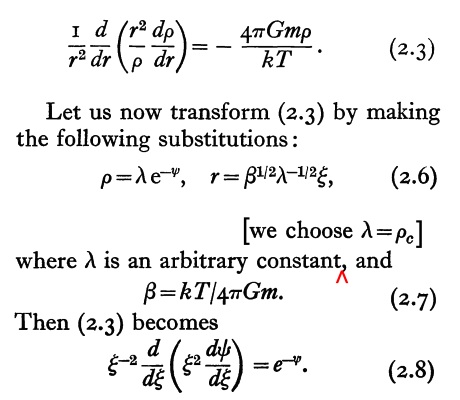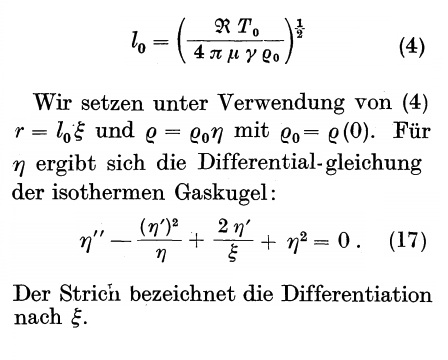Difference between revisions of "User:Tohline/SSC/Structure/BonnorEbert"
(→Governing Relations: Insert separate derivations from Bonnor and Ebert) |
(Blend Bonnor-Ebert discussion in with earlier discussion of Emden's isothermal sphere) |
||
| Line 2: | Line 2: | ||
{{LSU_HBook_header}} | {{LSU_HBook_header}} | ||
=Isothermal Sphere (structure)= | =Pressure-Bounded Isothermal Sphere (structure)= | ||
==Governing Relation== | |||
The equilibrium structure of an ''isolated'' isothermal sphere, as derived by [http://books.google.com/books?id=MiDQAAAAMAAJ&printsec=frontcover#v=onepage&q&f=true Emden] (1907), has been [[User:Tohline/SSC/Structure/IsothermalSphere#Isothermal_Sphere_(Structure)|discussed elsewhere]]. From this separate discussion we appreciate that the governing ODE is, | |||
<div align="center"> | <div align="center"> | ||
<math> | <math>\frac{1}{r^2} \frac{d}{dr}\biggl( r^2 \frac{d\ln\rho}{dr} \biggr) =- \frac{4\pi G}{c_s^2} \rho \, ,</math> | ||
</div> | </div> | ||
where | where, | ||
<div align="center"> | <div align="center"> | ||
<math>c_s^2 = \frac{\Re T}{\bar{\mu}} = \frac{k T}{m_u \bar{\mu}} \, ,</math> | <math>c_s^2 = \frac{\Re T}{\bar{\mu}} = \frac{k T}{m_u \bar{\mu}} \, ,</math> | ||
</div> | </div> | ||
is the square of the isothermal sound speed. In their studies of ''pressure-bounded'' isothermal spheres, [http://adsabs.harvard.edu/abs/1955ZA.....37..217E Ebert] (1955, ZA, 37, 217) and [http://adsabs.harvard.edu/abs/1956MNRAS.116..351B Bonnor] (1956, MNRAS, 116, 351) both started with this governing ODE, but developed its solution in different ways. Here we present both developments while highlighting transformations between the two. | |||
In their studies of pressure-bounded isothermal spheres, [http://adsabs.harvard.edu/abs/1955ZA.....37..217E Ebert] (1955, ZA, 37, 217) and [http://adsabs.harvard.edu/abs/1956MNRAS.116..351B Bonnor] (1956, MNRAS, 116, 351) both started with this governing ODE, but developed its solution in different ways. Here we present both developments while highlighting transformations between the two. | |||
<div align="center"> | <div align="center"> | ||
| Line 67: | Line 43: | ||
</tr> | </tr> | ||
</table> | </table> | ||
</div> | |||
Both of these dimensionless governing ODEs — Bonnor's Eq. (2.8) and Ebert's Eq. (17) — are identical to the one derived by Emden (see the [[User:Tohline/SSC/Structure/IsothermalSphere#Governing_Relations|presentation elsewhere]]), namely, | |||
<div align="center"> | |||
<math> | |||
\frac{d^2v_1}{d\mathfrak{r}_1^2} +\frac{2}{\mathfrak{r}_1} \frac{dv_1}{dr} + e^{v_1} = 0 \, . | |||
</math> | |||
</div> | |||
The translation from Emden-to-Bonnor-to-Ebert is straightforward: | |||
<div align="center"> | |||
<math> | |||
\mathfrak{r}_1 = \xi|_\mathrm{Bonner} = \xi|_\mathrm{Ebert}~~~~\mathrm{and}~~~~e^{v_1} = e^{-\psi} = \eta \, . | |||
</math> | |||
</div> | </div> | ||
Revision as of 20:57, 31 October 2012

|
|---|
| | Tiled Menu | Tables of Content | Banner Video | Tohline Home Page | |
Pressure-Bounded Isothermal Sphere (structure)
Governing Relation
The equilibrium structure of an isolated isothermal sphere, as derived by Emden (1907), has been discussed elsewhere. From this separate discussion we appreciate that the governing ODE is,
<math>\frac{1}{r^2} \frac{d}{dr}\biggl( r^2 \frac{d\ln\rho}{dr} \biggr) =- \frac{4\pi G}{c_s^2} \rho \, ,</math>
where,
<math>c_s^2 = \frac{\Re T}{\bar{\mu}} = \frac{k T}{m_u \bar{\mu}} \, ,</math>
is the square of the isothermal sound speed. In their studies of pressure-bounded isothermal spheres, Ebert (1955, ZA, 37, 217) and Bonnor (1956, MNRAS, 116, 351) both started with this governing ODE, but developed its solution in different ways. Here we present both developments while highlighting transformations between the two.
| Derivation by Bonnor (edited) | translation | Derivation by Ebert (edited) |
| <math>G \Leftrightarrow \gamma</math> | ||
| <math>\rho_c \Leftrightarrow \rho_0</math> | ||
| <math>\frac{kT}{m} \Leftarrow c_s^2 \Rightarrow \frac{\Re T_0}{\mu}</math> | ||
| <math>\beta^{1/2}\lambda^{-1/2} \Leftrightarrow l_0</math> | ||
| <math>e^{-\psi} \Leftrightarrow \eta</math> |
Both of these dimensionless governing ODEs — Bonnor's Eq. (2.8) and Ebert's Eq. (17) — are identical to the one derived by Emden (see the presentation elsewhere), namely,
<math> \frac{d^2v_1}{d\mathfrak{r}_1^2} +\frac{2}{\mathfrak{r}_1} \frac{dv_1}{dr} + e^{v_1} = 0 \, . </math>
The translation from Emden-to-Bonnor-to-Ebert is straightforward:
<math> \mathfrak{r}_1 = \xi|_\mathrm{Bonner} = \xi|_\mathrm{Ebert}~~~~\mathrm{and}~~~~e^{v_1} = e^{-\psi} = \eta \, . </math>
Related Wikipedia Discussions

|
|---|
|
© 2014 - 2021 by Joel E. Tohline |

